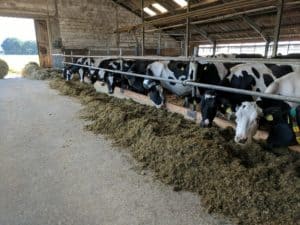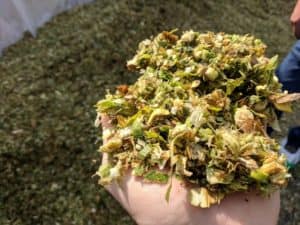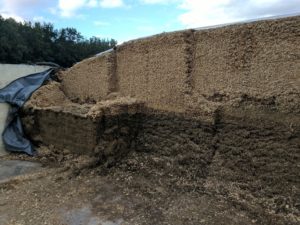
Cows on a German Dairy benefiting from better characterized feeds.
The AMTS EU Feedbank has been developed to provide our European customers with a feed library that more accurately represents feeds available to European farmers. Over the last 2-3 years, we have been collecting information and we are now rolling it out to you! We hope this helps bring value to our users but most importantly, we hope it will allow you to formulate diets to make the true end user (the cow!) healthier and more productive, and more environmentally friendly
Here are the main features of the new AMTS EU Feeds feedbank:
- Book values for fiber digestibility: We have pre-populated every NDF-containing feed in this feedbank with 3-time-point NDFd values. This will allow you to get a better handle on kd and uNDF levels during formulation. Including these values was especially important for improving model predictions in diets containing grass silage and rapeseed.
- An expanded Grass Silage selection: This group of forages is built mostly using analyses of Grass silages in Germany, the United Kingdom, Ireland, the Netherlands, and the Scandinavian countries. It most closely represents perennial ryegrasses from immature to mature.
- Maize silage with different physical forms: We expanded on the already large “Corn Silage” list from the CNCPS library to include Unprocessed Fine Chop and Shredlage options. The Shredlage entries will contribute slightly higher peNDF and starch digestibility book values. The Unprocessed, fine chop entries are built to represent forages that may have been harvested for biogas production but are also fed to cattle.

Fine-Chopped, Unprocessed Maize Silage–better for cows or digesters?
- Whole-crop small grains silages: Users will now be able to choose between different qualities of whole-crop silages. Values are based primarily on UK and German samples.
- Rapeseed derived products: We have recognized that European rapeseed meal is different than our stock “Canola Meal Solvent” in the CNCPS feed library. We have compiled analysis of European-sourced rapeseed meal, cakes, and protected feeds to give you a large selection of feeds in the library. In the field, we have seen many different commercial products based on rapeseed. We used generic names in the feed library, but if you bring a feed into a farm, you will see a small green box next to the feed name. Hover over this green box, and you will see a notes section with trade names for the specific generic feed.

- Selected commercial products: We have also included some commercial products that many of our users have specifically requested; we have worked with the suppliers to properly characterize these feeds. We hope this will bring increased value to AMTS users.
Do I still need to test my feeds?
YES! The feedbank will give you a better ‘base feed’ to work off. When you go to formulate diets with feeds represented in the feedbank you will want to select the feed out of this feedbank that most closely matches your tested values. Then, when you get your analysis, you can replace the book values with actual measured values…just like the rest of the AMTS feeds. Of course, standard XML import makes this task simple and fast!

How should I characterize this? Hmm…, I don’t see a “GrassMaize Silage” entry in the feedbank!
We would greatly appreciate your feedback.
As always, we would love to hear your thoughts! Would you like more feeds added to the feedbank? Contact us and we will let you know what type of data we need.

